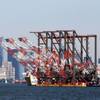Container Volumes Growth Sluggish
With fleet growth of 3.7%, compared to global container shipping demand growth of only 1%, even blanked sailings have been unable to lift freight rates, says BIMCO.
According to the largest international shipping association representing shipowners, container shipping has in the last few months felt the effects of the trade war digging in, as global container volumes continue to see very sluggish growth, now standing at 1% in the first nine months of the year.
This brings the total volume of containers shipped this year to 126.3 million TEU, up just 1.3 million from the corresponding level in 2018. All this compares with the 3.8% growth at this time last year, or an additional 4.6 million TEUs.
Front-loading at the end of last year, ahead of planned tariffs hikes on US imports from China, led to higher volumes as well as higher freight rates. Since February, volumes between the two countries have been consistently lower than last year. US containerized imports from China in tonnes are down 7.3% in the first nine months of the year.
Despite the fall in volumes from China, total containerized imports out of Asia have grown so far this year, albeit only just. Volumes are up 1.1%, compared to full year growth of 6.5% in 2018. 2018 growth was pulled up at the end of the year due to the front-loading.
In particular, volumes to the USWC have suffered, where laden container imports are down 1.5% in the first nine months of the year, according to BIMCO’s own data. Exports have also fallen by 4.2%.
Despite slowing growth and lower freight rates, charter rates for container ships, especially the largest vessel sizes, remain elevated. This is partly due to these larger ships leaving the market for scrubber retrofits.
Rates for an 8,500 TEU vessel have been standing at USD 30,000 per day for the past 11 weeks. This is a sign of weakness, as it indicates that demand has stalled; BIMCO expects to see lower charter rates in the coming months.
Charter rates for a 6,500 TEU vessel, after five weeks at USD 26,000 per day, have already fallen slightly, standing at USD 25,000 per day on 8 November 2019. Charter rates for smaller vessel sizes remain more subdued.
Fleet growth in container shipping has also slowed in recent years, although not as fast as the slowdown in global container shipping demand, meaning that the fundamental balance of the market has continued to worsen, to the detriment of freight rates and shipowners operating in this sector.
Growth in the container shipping segment now stands at 3.6%, and BIMCO expects full-year growth of 3.7%.
Carriers have announced further blanking of sailings (pulling a ship out of rotation) in November which, along with ships heading to yards for scrubber retrofitting amongst other things, has pushed the idle fleet up in all ship sizes in recent weeks.
However, despite the continued blanking of sailings, freight rates have not risen substantially as the fundamental balance has continued to deteriorate. This will only hurt carriers, especially as they face the final preparations before the implementation of the 2020 sulfur cap and the battle to pass on higher fuel costs to customers.
Although volumes being shipped between the Far East and Europe have remained high – up 4.6% from the same period of 2018 – this has done little to lift freight rates. The CCFI index to Europe in October was 10.5% lower in 2019 than in 2018 and, over the same period, the SCFI was down 17.1%.
The continued deployment of bigger ships, as well as the overall market conditions, mean that even high demand growth on a route cannot single-handedly lift rates on that route.














